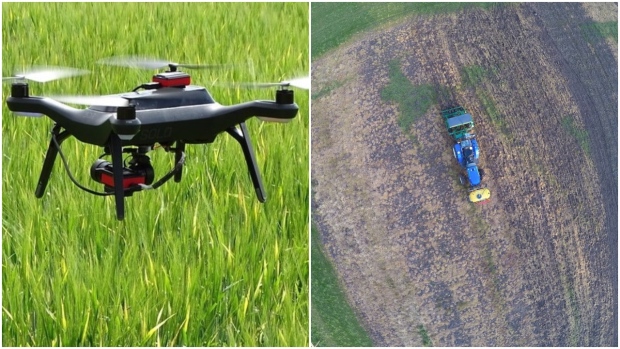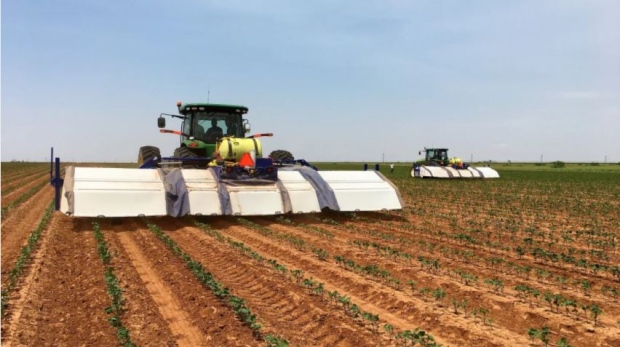
The Hands Free Hectare project, out of Harper Adams University in the U.K., successfully planted, tended and harvested 1.5 acres of barley using only autonomous vehicles and drones. (Hands Free Hectare)
Farming may not be the first industry that comes to mind when we think of technological advancement, but that’s changing — fast.
Agricultural giant John Deere, for instance, just spent $305 million to buy a robotics company. The farm machine manufacturer has been around for almost two centuries, but it too has felt the need to keep up with changing trends and tools, says Deanna Kovar, a marketing director for John Deere.
Its acquisition, Blue River Technology, is a startup that makes agricultural robots capable of identifying weeds and other unwanted plants, and dosing them with high-precision sprays of herbicide.
The smart sprayers operate much the same way as conventional spraying equipment, but these come equipped with computer vision, artificial intelligence and automated sprayers, with cameras that use machine-learning software to discern the difference between plants.
‘People assume farmers don’t use technology’
Right about now, you might be picturing farming Transformers that morph from tractors into bipedal robots and march through fields shooting pesticides out of spray guns.
In fact, these new robots work in conjunction with a traditional tractor. That’s part of their appeal for a company like John Deere — the smart machines aren’t making tractors obsolete but, rather, their addition makes the farming tools more advanced, and more appealing to potential consumers.

Agricultural manufacturing giant John Deere has acquired Blue River Technology, maker of ‘smart’ machines like the See & Spray, which uses artificial intelligence to identify weeds and robotic sprayers to dose them with herbicide. (Blue River Technology)
Now, this isn’t exactly farming’s first foray into tech. It’s worth remembering that tractors themselves were advanced technology for their time. Their invention revolutionized agriculture with an unprecedented leap in efficiency, as one machine was able to do the job of multiple farmhands.
Naturally, as our technological capabilities have evolved, agricultural tools have, as well.
“People assume that farmers don’t use technology,” says Saskatchewan-based farmer Kim Keller.
- Agriculture industry betting the farm on innovation to boost yields, profits
- Driverless tractor designed by Sask. man unveiled at farm trade show
“In fact, farmers are often on the forefront of using technology, and we use a lot of technology in our day-to-day operations,” says Keller says, creator of an app called Farm at Hand, which was designed to keep track of everything from seeding and harvesting schedules to equipment, stock and sales (it was later sold to FarmLink Marketing Solutions).
In addition to this kind of farm management software, some farmers use drones to monitor their fields and collect data on their crops.
And now, robots can even be the farmers.
The Hands Free Hectare project, out of Harper Adams University in the U.K., successfully planted, tended and harvested 1.5 acres of barley using only autonomous vehicles and drones.
Financial, environmental benefits
According to Jonathan Gill, a technical developer and researcher on the project, the team decided, “Let’s take the brains from a drone and put it in a ground rover that can actually do all of the tasks.
“An entire crop could be grown from start to finish without us ever going into the field.”
Beyond improving efficiency, new tools like these could have a positive environmental impact.
According to Kovar, Blue River’s smart system can significantly cut down the use of herbicides, pesticides or other agricultural chemicals.
“The sprayers can pass over the entire field but only put the crop protectant on the weed, reducing — by dramatic amount — the product that has to be sprayed across the field.” says Kovar.
Keller explains that traditional farming equipment, which has steadily grown in size, can be taxing on soil health and, ultimately, on crop yield. “If the ground is compacted, it becomes a lot harder for plants to grow,” she said.
Machinery that doesn’t require a human driver can reduce the weight and size of the equipment, thus compacting the ground less.
There are potential financial benefits, too. “I think that we’re in a really exciting time in agriculture and there’s a lot of change happening,” says Keller. “There’s a lot of investment going into agriculture, and farmers aren’t quite seeing that return yet, but I do think in the coming years that that will change.”
While the Hands Free Hectare project was an expensive experiment subsidized by the U.K. government, the assumption is that each subsequent crop will be cheaper. That is, after all, one of the motivations behind the adoption of automated systems.
Tractor hacks
But with each step forward comes new challenges. For instance, as John Deere’s tractors have become more advanced, they have become reliant on proprietary software. While the machines might be capable of impressive operations — like automated steering — farmers are no longer able to fix their tractors themselves when they break down, and are contractually at the mercy of the manufacturer or software developer for maintenance.
That’s led some farmers to track down hacked versions of the software on the black market, in an attempt to gain back a little bit of control over their machinery.
- Farming industry facing huge labour shortage, new study finds
- Saskatchewan farmer hacks his ‘smart’ tractor to avoid costly dealer fees
And then there’s the perennial automation-related question: What about job loss?
“The jobs have already been lost,” Gill notes.
“What we’re trying to actually do is increase the skill level that farm workers will have, where they’ll become a fleet manager overseeing the autonomous vehicles,” he said. While the repetitive motions of crop tending can be done more effectively and with more precision by autonomous vehicles, the agronomy and all of the difficult decisions still need to be done by humans, he said.
From Keller’s perspective, as the industry evolves, jobs won’t disappear, they’ll just change — and that could be a good thing. “Maybe it will free us up from doing very labour-intensive jobs to doing jobs in other parts of our operation,” she says.
“It’s sort of like the old adage: you’re able to spend a little bit less time in your business and a little bit more time on your business.”
[“Source-cbc”]
